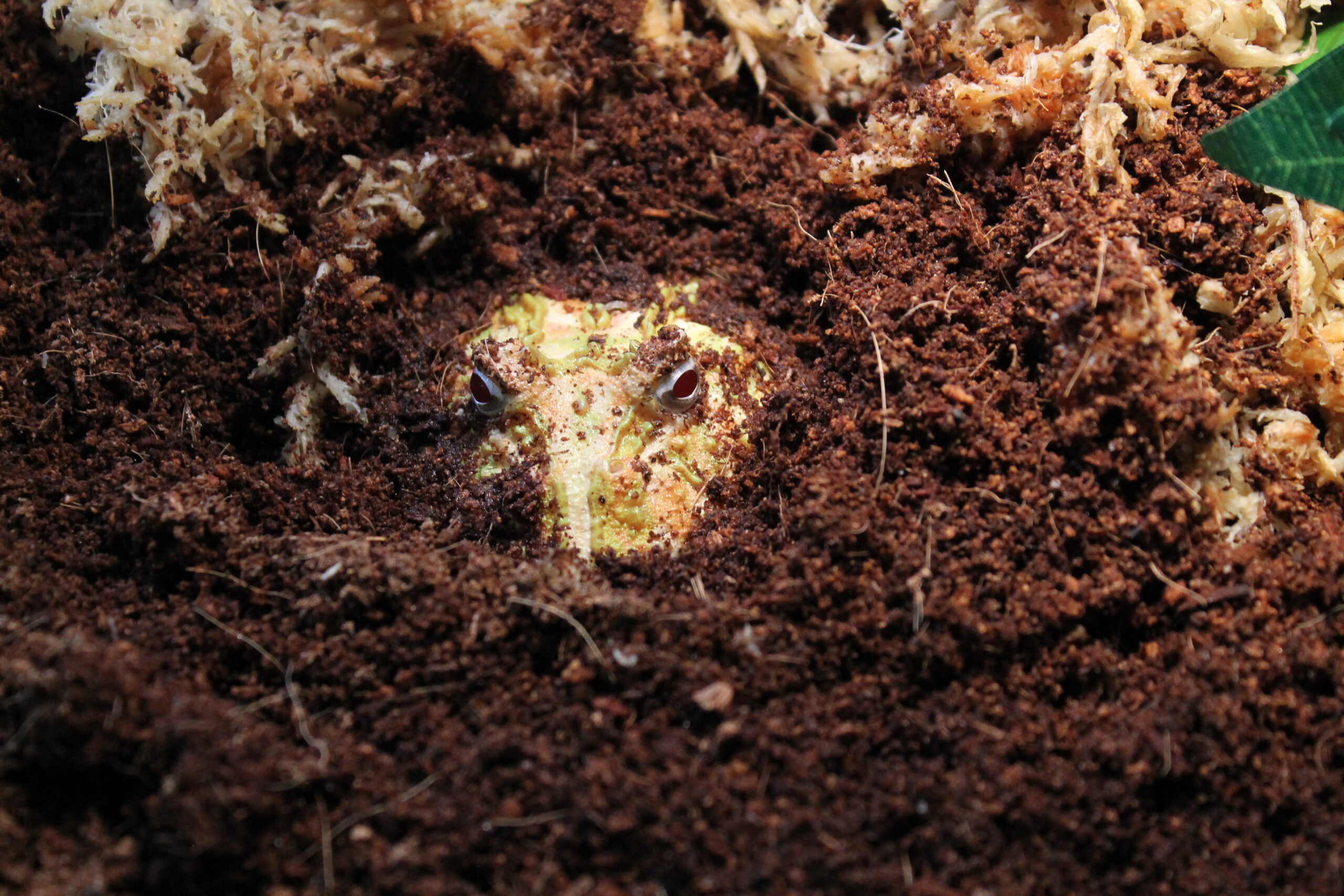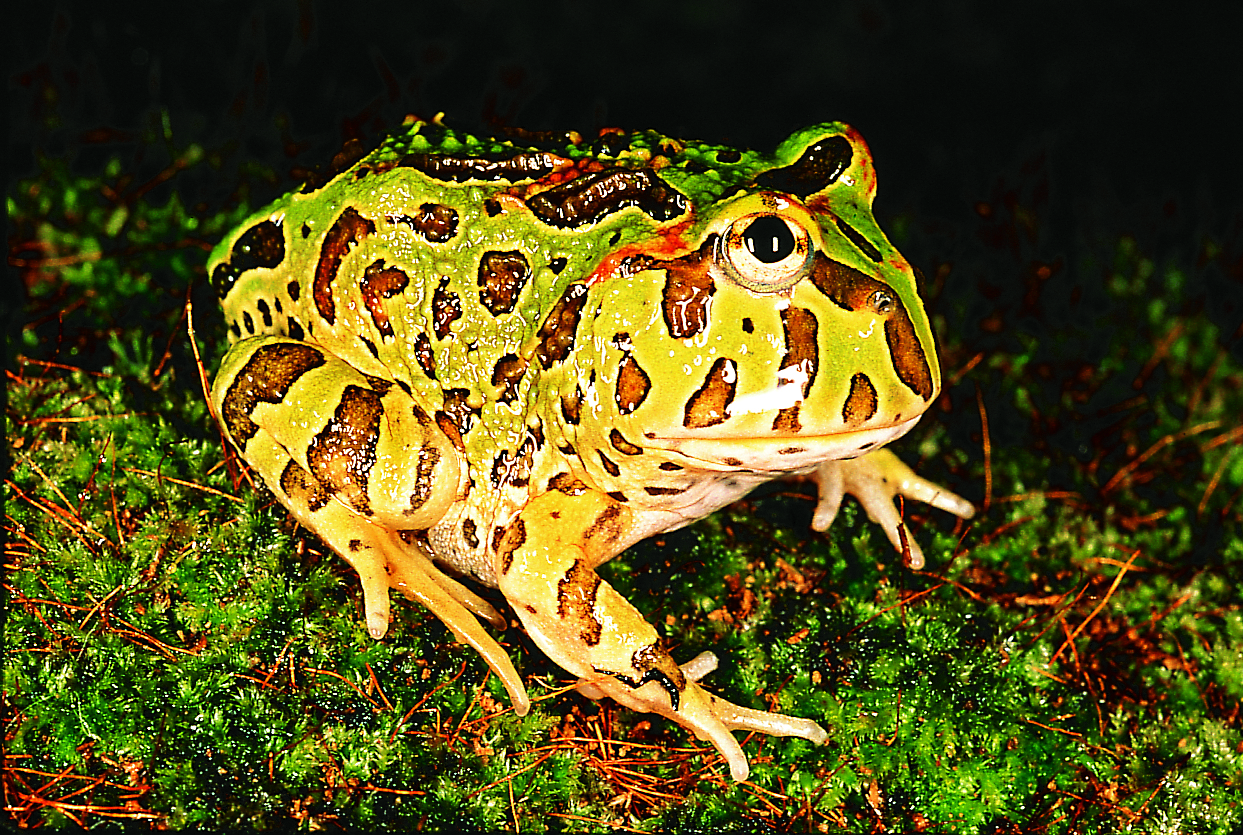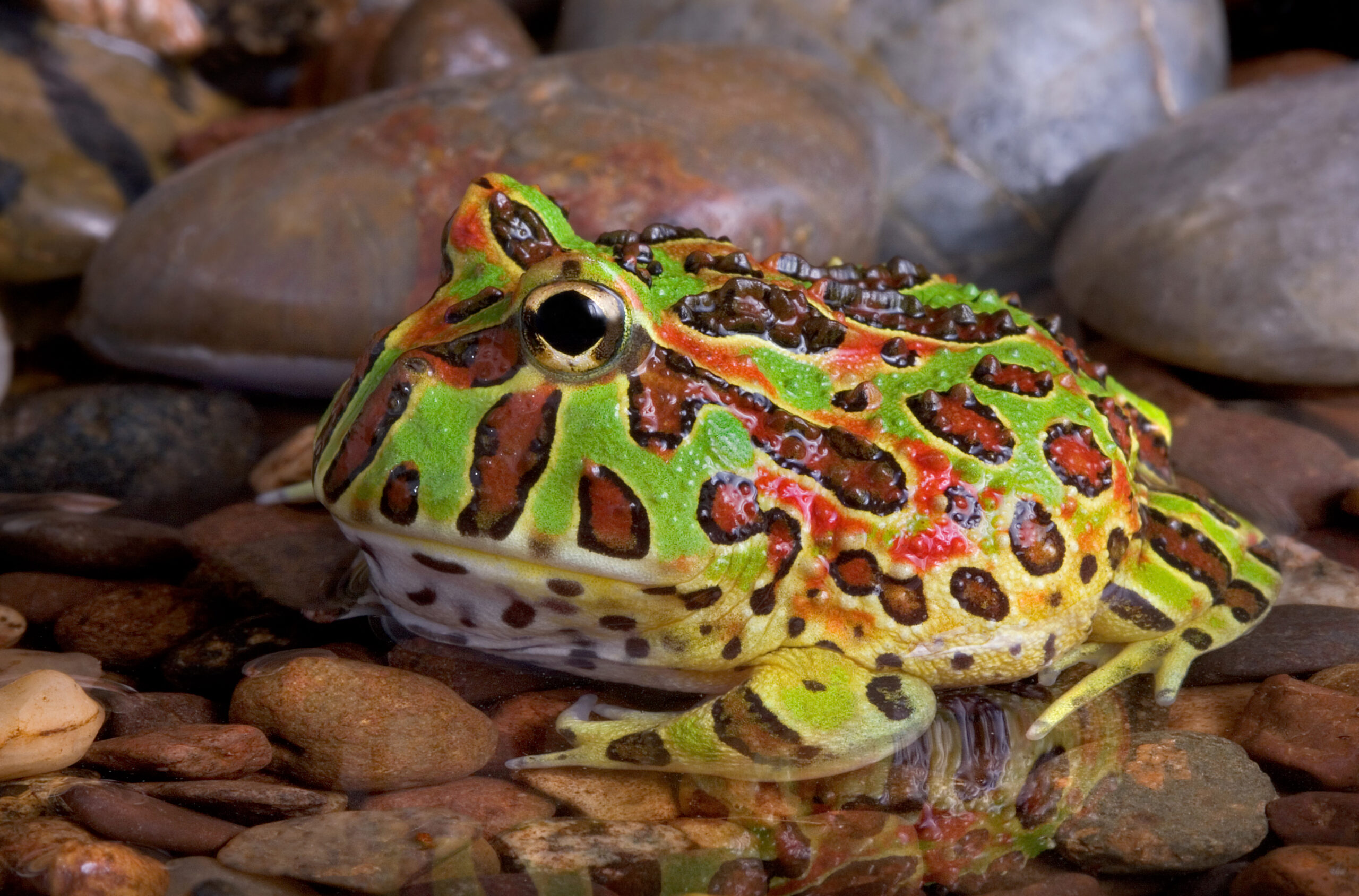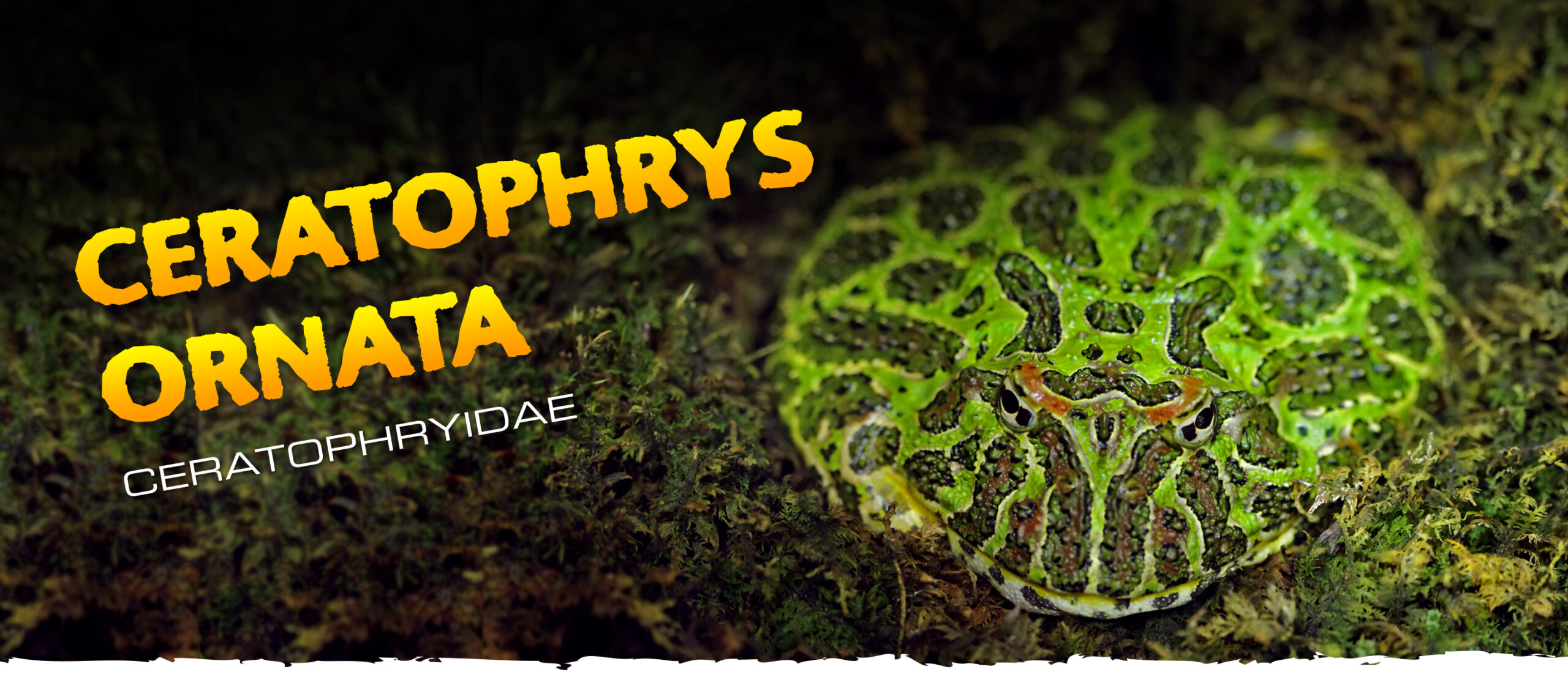
Ornate Horned Frog
Ceratophrys ornata
LATIN NAME
FAMILY
ADULT SIZE
LIFESPAN
RANGE
HABITAT
TEMPERATURE
HUMIDITY
UVB CHART
SKILL LEVEL
LATIN NAME
FAMILY
ADULT SIZE
LIFESPAN
RANGE
HABITAT
TEMPERATURE
HUMIDITY
UVB CHART
SKILL LEVEL
Ornate Horned Frogs are hardy, long-lived, and “easy-to-care-for” amphibians. These large, terrestrial, burrowing frogs are native to South America and are characterized by more or less developed fleshy horns projection above the eyes.
The Ornate Horned Frog is only one of eight species of Horned Frogs:
- Ornate Horned Frog (Ceratophrys ornata)
- Cranwell’s Horned Frog (Ceratophrys cranwelli)
- Suriname Horned Frog (Ceratophrys cornuta)
- Brazilian Horned Frog (Ceratophrys aurita)
- Caatinga Horned Frog (Ceratophrys joazeirensis)
- Venezuelan Horned Frog (Ceratophrys calcarata)
- Pacific Horned Frog (Ceratophrys stolzmanni)
- Ecuadorian Horned Frog (Ceratophrys testudo)
The Ornate Horned Frog is one of the most commonly kept and bred Ceratophrys species. Horned Frogs are colorful and rather easy to breed which makes these fun frogs an ideal species for both the beginning amphibian enthusiast as well as for the advanced hobbyist. Captive-bred youngsters are readily available and come in a variety of colors & patterns. Next to the more common color morphs like Pattern-less Green, Strawberry, Sunburst, Albino or Chocolate, there are even hybrid morphs available called Fantasy Frogs.
Horned Frogs are commonly called Pac Man Frogs because their rounded shape and huge mouth resemble the animated character in the video game. Just like in the Pac Man game, the Horned Frogs devour everything that crosses their path.
History
Prince Maximillian von Wied-Neuwied, a German explorer, ethnologist and naturalist first described the Genus of Horned Frogs as Ceratophrys in 1824 following his expedition to the Southeast of Brazil between 1815-1817. A first characteristic image of the Ornate Horned Frog was shown in the famous Zoology of the Voyage of H.M.S. Beagle (1832-1836) where they placed the newly discovered frog in the Genus Uperodon (Uperodon ornata).
In 1858 Günther described the Ornate Horned Frog to the correct Genus as Ceratophrys ornata in the Catalogue of the Batrachia Salientia (Collection of the British Museum, London).
Horned Frogs became a popular species for frog enthusiasts, and lots of them were imported from their countries of origin. But as with many other reptile and amphibian species, the export and import became more and more restricted over time. Fortunately, the herpetocultural pioneers Philippe de Vosjoli and Robert Mailloux ensured through large scale captive breeding programs, that captive bred Horned Frogs remained sufficiently available for the amphibian hobbyist.
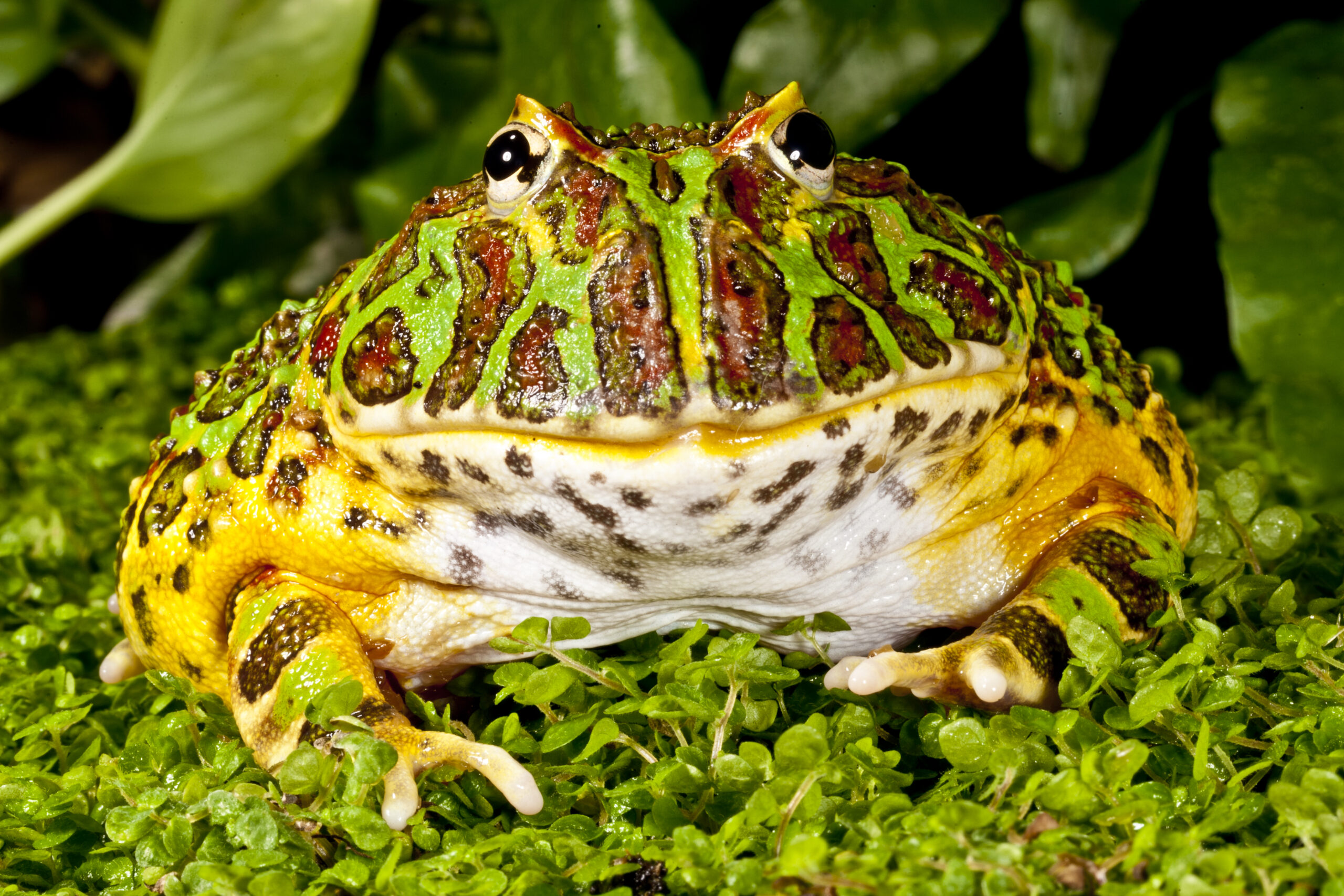
Adult Ceratophrys ornata on vegetation - by David Northcott.
Characteristics
Horned frogs are rather plump frogs, with a large, rounded body and short legs. Their most distinct characteristic are the more or less developed fleshy horns projecting above the eyes. Their base color varies depending on the specimen between green, brown-green and yellowish with a pattern of dark-green, brown, yellowish/cream-colored spots and patches. Their belly consists of a creamy-white base with various irregular, darker spots. Since some of the captive bred Horned Frogs are hybrid forms the characteristics and coloration may vary. Females clearly outgrow their male counterparts with lengths between 5”- 6” or 12 – 16cm, while males generally become 3”- 4” or 8 – 10cm. Once adult, the male frogs can be recognized by the, typically amphibian, nuptial pads on the forelimbs and the loose skin on their throat, indicating their “vocal sac”. The male’s “croaking” sounds more like a duck in distress than the croaking of a frog. Amazingly, also the Horned Frog tadpoles produce a (short metallic-like) sound underwater as part of their antipredator mechanism.
Horned Frogs grow rapidly and turn into impressive frogs with a huge mouth that allows them to eat quite large prey items. They become sexually mature when they’re about 18 months of age.

Close-up of juvenile Ceratophrys ornata on black background - by L. Espinosa y Urrutia.
Distribution
Ceratophrys ornata is found in the Pampa region of Argentina (Buenos Aires, Cordoba, Entre Rios, La Pampa, Mendoza Santa Fe Provinces), Uruguay and Southern Brazil.

Horned Frogs are nocturnal and follow a strictly terrestrial lifestyle. They’re heavy-bodied and not really capable of jumping. This makes them the typical sit-and-wait predator, spending most their time buried in the leaves and substrate, with only the eyes and horns peeking out, waiting for prey passing by.
Their habitat includes tropical grassland and forest near temporary water bodies like puddles and ditches, but they also gladly inhabit irrigated croplands.
The climate in their habitat is characterized by a dry and a wet season. Temperatures during the warmer months (October-April) fluctuate between 28°-32°C, combined with abundant rainfall, while the cooler months (May-September) show average temperatures between 18°-22°C and very little rainfall. The average humidity ranges between 65-80%.
Ornate Horned Frogs aestivate during the colder, drier winter season. They bury themselves and cover their skin with a protective layer to shield themselves from dehydration. In late spring, when temperatures rise and abundant rainfall creates shallow temporary pools, they emerge to indulge themselves in the mating process.
Since Horned Frogs live a strictly terrestrial life, and they’re not great at jumping, they require horizontally orientated terrariums rather than vertically orientated ones. Because of their inactive lifestyle, spending most of their day fully or partially buried in the substrate layer, these frogs do not need a spacious terrarium. In fact, Horned Frogs mostly fare better in smaller spaces, so they can reach their prey easier.
Horned Frogs are very territorial and even cannibalistic, so apart from the mating season they should be kept individually.
Terrarium
The Exo Terra® Breeding Boxes are ideal to raise Horned Frog youngsters. These Breeding Boxes are easy to handle, easy to clean and they have a special feeding door that makes it easy to feed your young frogs. The set-up can consist of a 1 inch (2,5cm) layer of moist Plantation Soil, a water dish, a hide and some live Pothos leaves or Exo Terra® artificial plants to increase the visual barriers and reduce the stress factor for the young frogs.
Once the frogs become of size, they should be transferred to an Exo Terra® Dart Frog Terrarium (PT2745 – 45 x 45 x 45 cm / 18” x 18” x 18”) or an Exo Terra® Natural Terrarium Small/Wide (PT2605: 45 x 45 x 45 cm / 18” x 18” x 18”).
The set-up can be a simple “rain chamber-type” terrarium with a 1 – 1.5 inches (2,5-3,8cm) water part with some branches and live Pothos plants or Exo Terra® artificial plants. Or you can create a more natural, bio-active type set-up with a separate land and water part mimicking a lakeshore or riverbank, by using the Bio Drain system. With a combination of sturdy artificial and live plants, you can provide the much-needed foliage which will allow the frogs to rest and hide in shaded areas of the Terrarium.
Exo Terra® Natural Terrariums are designed by European herpetologists and offer several housing options for Horned Frogs. These glass terrariums feature front opening doors, allowing easy access for maintenance and feeding and a unique double ventilation system with full screen stainless steel top.

The Exo Terra® Frog Terrariums even come with a built-in drain and tap valve which allows you to easily drain out excess spray water. This drain will come in handy when simulating the rainy season to induce mating behaviour in your frogs. The single front opening door allows maximum viewing pleasure and provides easy access for maintenance and feeding. A push-button lock keeps the terrarium secure and can even be outfitted with an optional lock to prevent unwanted opening. The hinged cover can be locked and unlocked with a single button and can be fully opened. A clear glass panel in the front ensures maximum visible light penetration and a stainless-steel ventilation strip in the back guarantees optimal ventilation. The patented dual ventilation system keeps the single front glass door free of condensation, even in humid conditions. It creates a natural upward flow of air to ensure optimal and healthy conditions. Excess heat is dissipated through the top mesh and prevents heat from accumulating, creating temperature gradients in the terrarium. The screen mesh allows UV and infrared penetration when these bulbs are required. Four self-closing inlets for wire/tubing in the back facilitate the installation of powered accessories like waterfall pumps, filters, the Exo Terra’s Monsoon, etc. The inside front of the lid has a Monsoon Nozzle mounting point on each side of the terrarium. The bottom part of the terrarium is waterproof once the tubing, elbow-connector and tap valve are connected to the drain. The drain allows hassle free water changes and excess water removal.
Horned Frogs are strictly terrestrial and thrive best in any of the following Terrarium landscapes which simulate the natural biotope of the frogs:
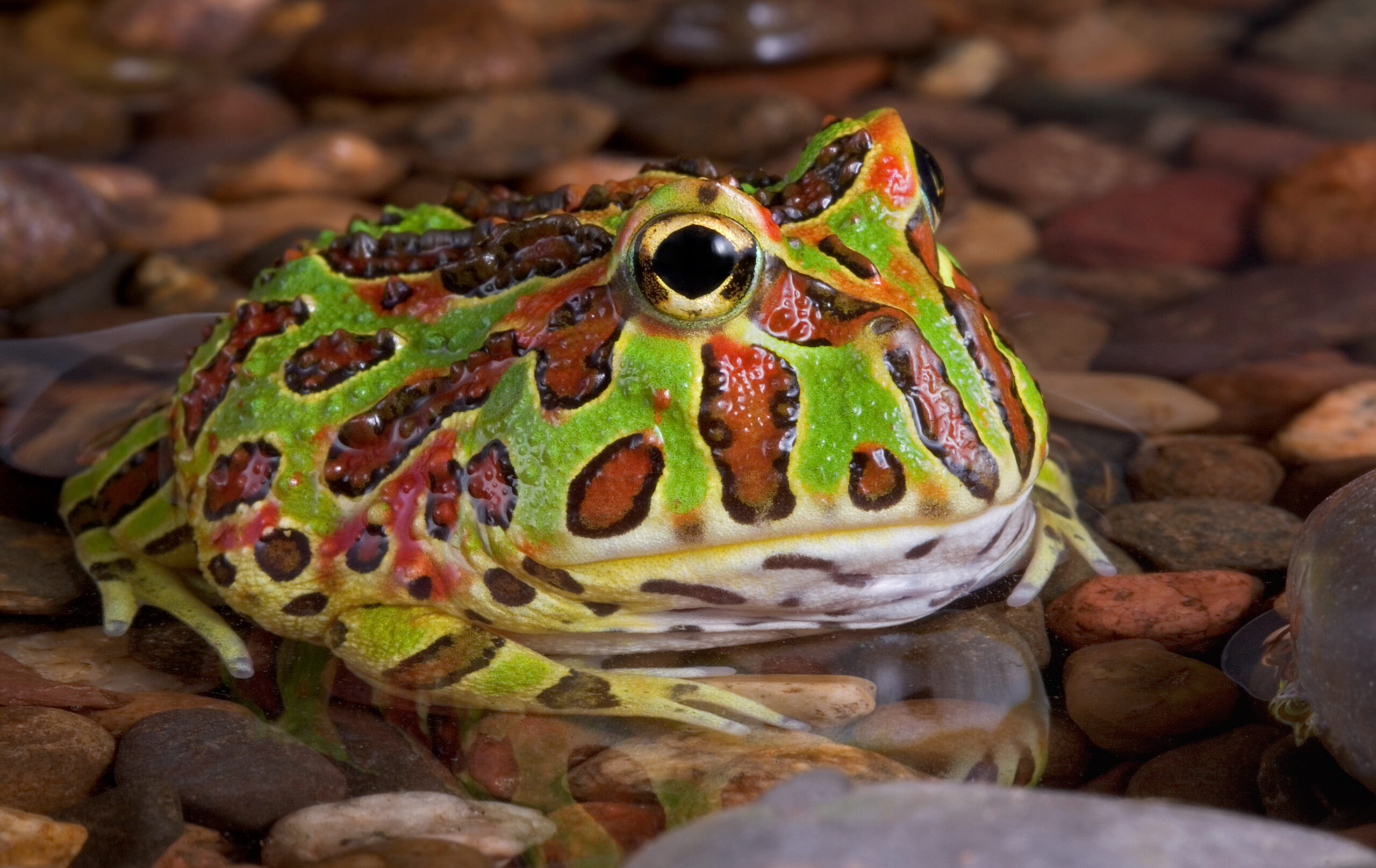
A baby ornate horned frog is bathing in a shallow pool.
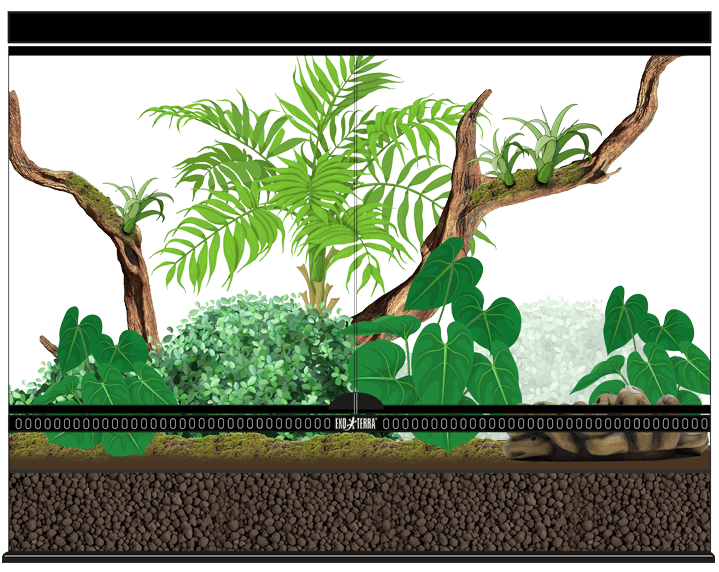
Rain Chamber Paludarium
The Rain-chamber Paludarium landscape replicates the semi-aquatic environment of a tropical forest during heavy rainfall. The rain-chamber paludarium can be used as a permanent habitat for aquatic, semi-aquatic or tree frogs, but the main purpose is to induce breeding in frog species that live in the riparian zone or come to the riparian zone during the mating season. Since the landscaping of this terrarium is reduced to the bare minimum, most hobbyists prefer to use the rain-chamber paludarium only for breeding purposes and keep their frogs in a nice bioactive set-up for the rest of the year. The rain-chamber paludarium landscape utilizes the complete bottom part of the terrarium as a water body for hydration and egg deposition. The landscaping consists of diagonally placed branches and cork pieces reaching to the top of the terrarium and some sturdy aroid plants like Pothos, Philodendron, Monstera, etc. and some bromeliads.
Tropical Forest Floor Terrarium
The Tropical Forest Floor Terrarium landscape replicates the understory layer of the tropical moist forest with an abundance of smaller branches covered with leaves, but with a somewhat less dense vegetation of epiphytic plants like orchids, bromeliads, aroids (Pothos, Philodendron, Monstera, etc.), air plants (Tillandsia spp.), lichens, mosses and ferns, compared to the rainforest environment. The substrate in this habitat is covered with patches of moss and lots of leaf litter. The Tropical Forest Floor Terrarium landscape mimics the microhabitat of frogs living in the understory layer of the forest, where only smaller water bodies occur, with no pond, stream or river in the immediate vicinity. This terrarium landscape utilizes a water dish (such as the Frog Pond) for hydration and egg deposition. The Tropical Forest Floor Terrarium habitat can best be replicated in horizontally oriented terrariums.
For breeding purposes, the Horned Frogs should temporarily be housed in the following Terrarium landscape:
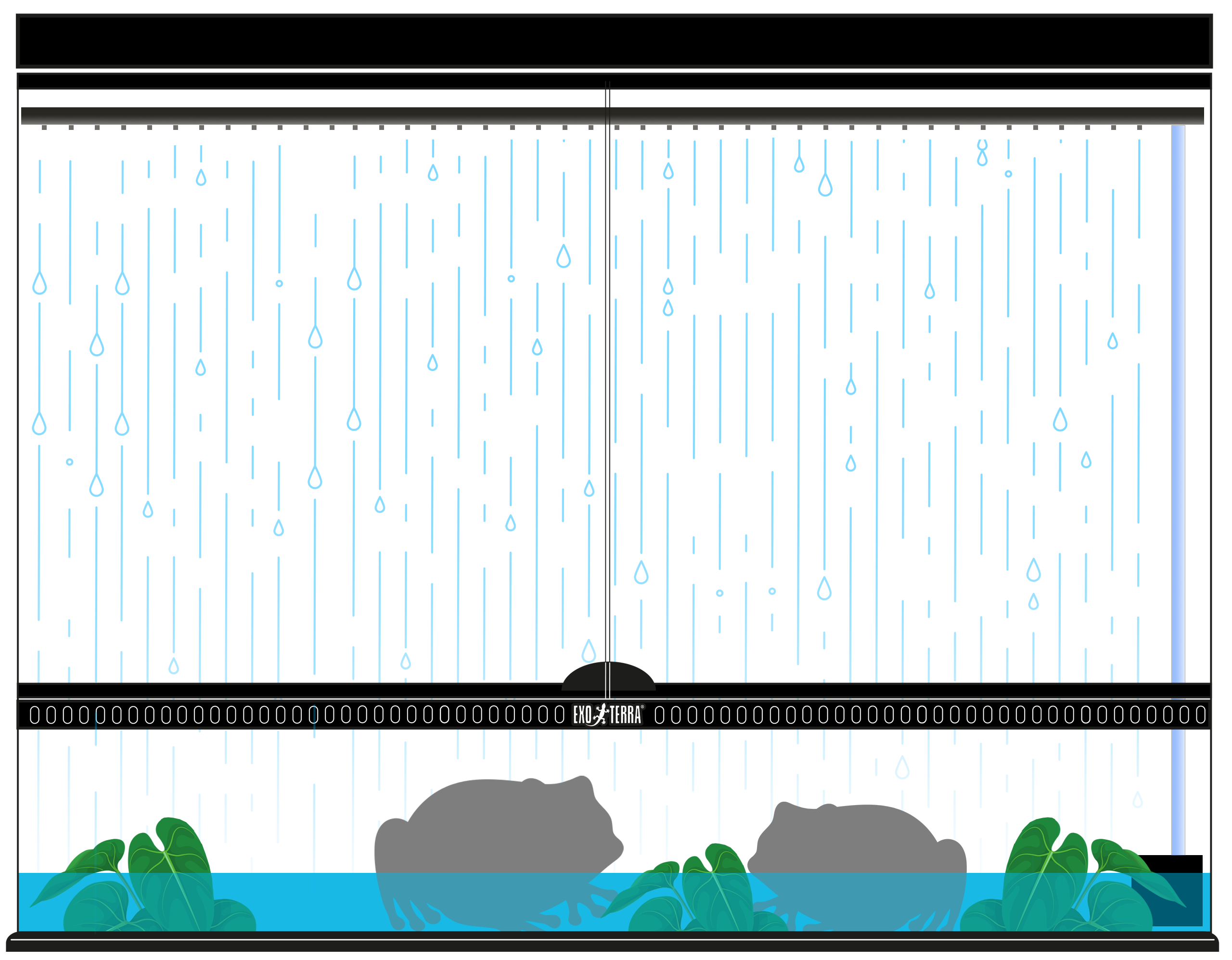

Tropical Forest Floor Terrarium
The Tropical Forest Floor Terrarium landscape replicates the understory layer of the tropical moist forest with an abundance of smaller branches covered with leaves, but with a somewhat less dense vegetation of epiphytic plants like orchids, bromeliads, aroids (Pothos, Philodendron, Monstera, etc.), air plants (Tillandsia spp.), lichens, mosses and ferns, compared to the rainforest environment. The substrate in this habitat is covered with patches of moss and lots of leaf litter. The Tropical Forest Floor Terrarium landscape mimics the microhabitat of frogs living in the understory layer of the forest, where only smaller water bodies occur, with no pond, stream or river in the immediate vicinity. This terrarium landscape utilizes a water dish (such as the Frog Pond) for hydration and egg deposition. The Tropical Forest Floor Terrarium habitat can best be replicated in horizontally oriented terrariums.
For breeding purposes, the Horned Frogs should temporarily be housed in the following Terrarium landscape:
Rain Chamber Paludarium
The Rain-chamber Paludarium landscape replicates the semi-aquatic environment of a tropical forest during heavy rainfall. The rain-chamber paludarium can be used as a permanent habitat for aquatic, semi-aquatic or tree frogs, but the main purpose is to induce breeding in frog species that live in the riparian zone or come to the riparian zone during the mating season. Since the landscaping of this terrarium is reduced to the bare minimum, most hobbyists prefer to use the rain-chamber paludarium only for breeding purposes and keep their frogs in a nice bioactive set-up for the rest of the year. The rain-chamber paludarium landscape utilizes the complete bottom part of the terrarium as a water body for hydration and egg deposition. The landscaping consists of diagonally placed branches and cork pieces reaching to the top of the terrarium and some sturdy aroid plants like Pothos, Philodendron, Monstera, etc. and some bromeliads.

Lighting
Horned Frogs are primarily nocturnal and will spend most of the day buried in the substrate layer of the terrarium.
A 12-hour day/night cycle will benefit your frogs and stimulates live plant growth. Providing UV-lighting is not absolutely necessary, but we do recommend the use of our Exo Terra® Reptile UVB100. The low levels of UVB-rays produced by these bulbs are beneficial for the animal’s overall health while the UVA rays stimulate appetite, activity and reproductive behavior.
Incandescent lights, like the Exo Terra® Daytime Heat Lamp or the Night Heat Lamp are recommended to provide heat if temperatures are too cool (see “Heating” section).
Heating
Given the opportunity, Horned Frogs will spend most of their day buried in the thick, moist substrate layer. Their preferred day time temperatures is about 75-82°F or 24-28°C with a 3-7° F or 2-4°C nighttime drop.
An Exo Terra® Light Dome or Reptile Dome with Light Bracket and a Daylight Basking Spot, Halogen Basking Spot or Swamp Basking Spot will provide them with a perfect temperature gradient during daytime. The Night Heat Lamp can be used for 24-hour heating if it’s used in combination with a light emitting bulb during the day. Refer to the charts in the Lighting section to select the right bulb wattage.
An Exo Terra® Heat Mat can also be used if applied to one side of the terrarium, creating a temperature gradient. Do not apply the Heat Mat under the terrarium, as this will dry out the substrate rather quickly.
Use 2 Digital or Analog Exo Terra® Terrarium Thermometers, place one in the warm and one in the cooler side of the Terrarium, this allows you to keep a keen eye on matching the preferred temperature gradients. The Heat Lamp or Heat Mat wattage may need to be adjusted depending on the ambient room temperature and the terrarium type used. To ensure the perfect ambient temperature for your Frogs, an Exo Terra® Thermostat can be used (see Monitoring section).
Temperatures below 65°F or 18°C and above 86°F or 30°C for longer periods can be fatal to Horned Frogs.
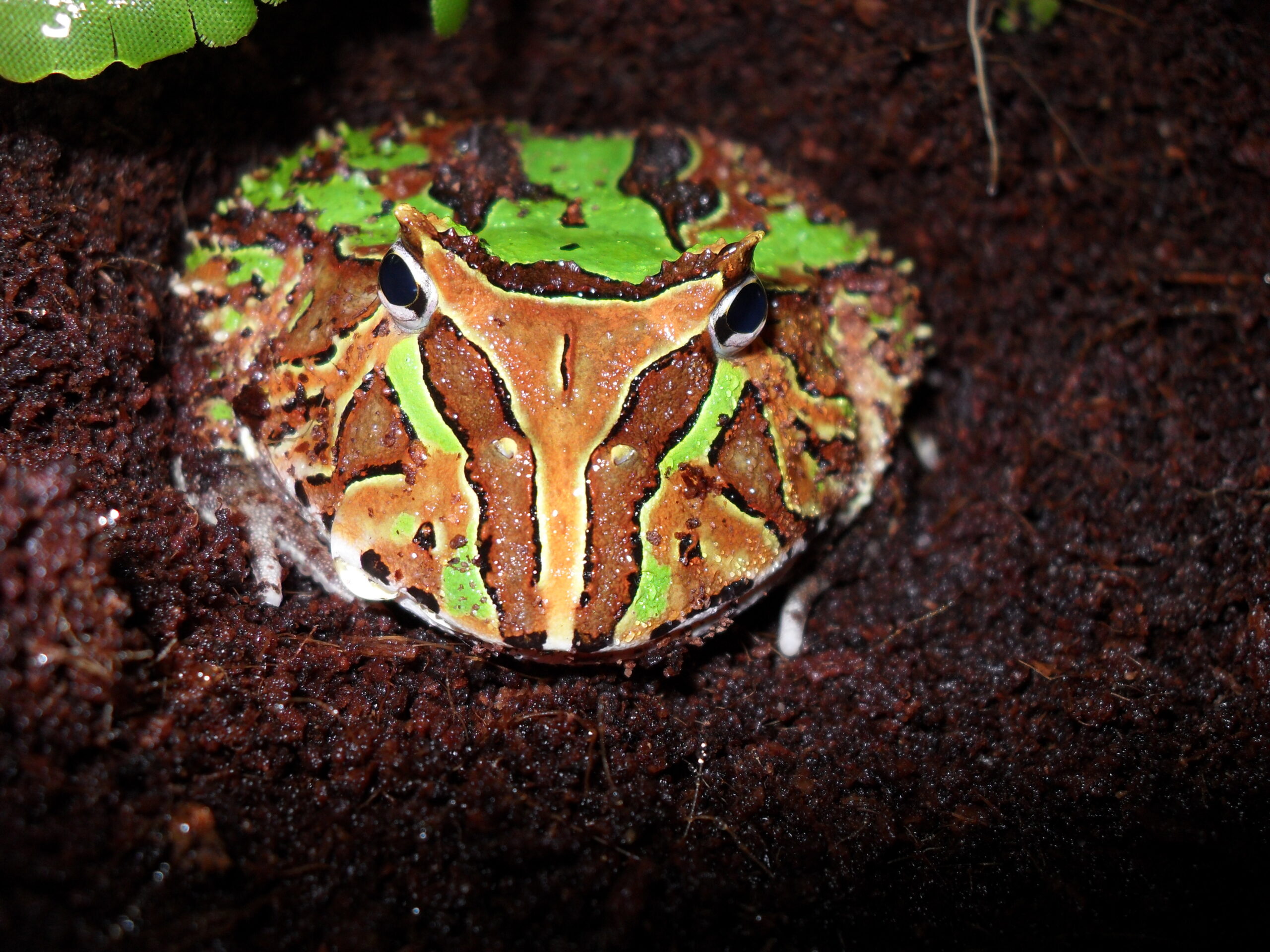
Juvenile Ceratophrys ornata partially buried in soil.
Monitoring
Horned Frogs require a specific temperature range both during the day (75-82°F or 24-28°C) as well as during the night (72°-75°F or 22-24°C) – (see “Heating” section).
An average relative humidity between 65-80% is sufficient all year round except during the mating season. During the mating season the humidity needs to be increased to 90%.
Use the Exo Terra® Digital or Analog Thermometers and Hygrometers to help you monitor the terrarium conditions and adjust the temperature and relative humidity to meet the needs of your animals.
For more security and peace of mind, the Exo Terra® Thermostats or Thermostat & Hygrostat will help to prevent overheating and undercooling during hot summer days or cold winter nights. Apart from the temperature, the Exo Terra® Thermostat & Hygrostat will also keep the humidity at the desired level, if used in combination with an Exo Terra® Humidifier or Fogger. With the Exo Terra® Thermostats or Thermostat & Hygrostat you can create a well-controlled heating/humidifying system that allows you to maintain the required temperature and/or humidity conditions similar to those found in your animal’s environment.
Substrate
Horned Frogs are strictly terrestrial and need a 4 to 8 inch or 10 to 20 cm thick layer of substrate to burrow and hide.
The substrate layer can consist of a single layer, or for advanced drainage and aeration, you can use the multi-layered Bio Drain System. In the Bio Drain System, you use an inorganic bottom drainage layer, like Exo Terra® Bio Drain Substrate or Exo Terra® Sub Stratum, which you cover completely with the non-decomposable Bio Drain Mesh. This will allow proper water drainage and aeration of the substrate layers you will built up on top. The actual substrate layer that the frogs will use for burrowing can consist of the Exo Terra® Sub Stratum or a mix of Exo Terra® Plantation Soil with Sphagnum Moss or Forest Moss and some Coco Husk chunks. Both the Sub Stratum and the Plantation Soil mix (with some Coco Husk chunks) allows for proper drainage and aeration, preventing foul smells often associated with damp soils.
The Exo Terra® Sub Stratum is a natural volcanic soil with live beneficial bacteria. The porous surface and low-density structure allow for excellent drainage and aeration, but it also promotes a flourishing population of beneficial, nitrifying bacteria, creating a self-sustaining, living terrarium ecosystem. The active beneficial bacteria of the soil will decompose biological waste, keeping the terrarium clean and healthy.
The Exo Terra® Plantation Soil is a 100% natural, biodegradable terrarium substrate made from sustainable, ground coconut husk fiber grown on plantations in tropical Asia. The unique hygroscopic properties of this ecological substrate regulate the terrarium’s humidity in a natural way and is totally safe for frogs, salamanders and other burrowing or digging animals. The unique coir pith used for the Exo Terra® Plantation Soil consists of a mixture of short fibers and coco-peat grain sizes ranging from coarse granules to fine clumps resulting in improved soil drainage and aeration. The improved aeration of the substrate promotes the cultivation of healthy waste-reducing organisms keeping your terrarium fresh and clean.
The substrate should be kept moist, but not soaking wet, at all times. Make sure to offer different gradients of moisture inside the terrarium. Some parts can be kept rather moist while other parts should be kept somewhat drier. Young frogs prefer a somewhat more moist environment compared to adults. Also, try to vary the moisture depending on the season, spray more frequently during the warmer parts of the year.
The Exo Terra® substrates will help maintain the substrate moisture at an optimal level. Providing a top layer of Exo Terra® Leaf Litter or Forest Moss will also facilitate the substrate’s moisture retention and prevent it from drying out. The Leaf Litter or Forest Moss also provides hiding spots for the reptiles and amphibians foraging the forest floor and at the same time, facilitate the natural ecosystem where beneficial organisms will break-down waste products and thus reduce odors.
The secret to growing healthy plants begins with the soil. Naturally, healthy soil contains living microorganisms — from bacteria to fungi, protozoa and arthropods. Together they form a choreographed exchange from the recycling of nutrients to the decomposition of organic materials.
Plants
Considering their natural behavior, spending most of the day buried in the substrate, Horned Frogs should be provided with visual barriers to hide and feel secure. Adding decorative live and Exo Terra® artificial plants to your terrarium will provide extra cover and increase the frog’s sense of security and reduce stress.
Using live plants, such as Pothos, provides hiding spots and contributes to the bioactive process in the terrarium. Many hobbyists choose to introduce live plants in pots that are buried in the substrate and concealed with decor items, like cork bark or rocks. The Exo Terra® Snake Bowl can be used as a decorative planting pot. Its extra deep design makes it suitable for small to medium live terrarium plants. The Exo Terra® Large and X-Large Water Dish can be used for multiple plants. Planting your live plants in Exo Terra® dishes prevents them from being dug up by the frogs.
DISCLAIMER Make sure they have no pests before introduction and rinse leaves thoroughly to remove any pesticide residues.
Exo Terra® offers a wide range of artificial plant with the same advantages as live plants; they’re decorative, they provide shade and they create hiding spots and visual barriers to let your reptiles and amphibians experience an increased feeling of safety and reduced stress. Exo Terra’s artificial plants are exact copies of their natural counterparts to blend in well with live plants but are much easier to maintain. A combination of live plants and Exo Terra’s artificial plants allows you to fully plant a terrarium, even in the hottest or driest parts.
Exo Terra®’s Bromelia’s and Ground Cover Plants are easy to clean & maintain, while the weighted base allows you to easily position the plant after maintenance.

Juvenile Ceratophrys ornata hiding in foliage.
Hide-outs
Horned Frogs spend most of their day hiding, so to prevent stress we should provide as many as possible visual barriers and hiding spots.
Apart from supplying a thick top layer of Exo Terra® Leaf Litter or Forest Moss, adding some Exo Terra® Ground Cover Plants in the terrarium will also help to provide visual barriers. An additional decorative hide like the Exo Terra® Reptile Cave or an Exo Terra® Skull type hide will add even more privacy to your frog’s habitat. Given that the humidity underneath this hide-out will remain higher compared to the more open areas in the habitat, these decorative hide-outs will contribute to maintaining a necessary moisture gradient in your frog’s terrarium.
Decor
Landscaping a terrarium will not only encourage the frog’s activity and exploratory behavior, but also provide extra cover which increases the frog’s sense of security and reduces its stress levels.
Next to the necessary items like leaf litter, plants and hide-outs – the terrarium can be “beautified” with some additional decor items. Care however needs to be given to not over clutter the open space in the terrarium.
Exo Terra® offers a wide variety of innovative decor items like Skulls, Waterfalls, Ground Cover Plants, etc. – all which add next to personalizing accents, some more environment enrichment and features.
Diet
Horned Frogs are ambush predators that sit and wait until a prey item passes by. In nature Horned Frogs feed on a huge variety of prey items, everything that fits their huge mouth will be devoured; from frogs, lizards and small snakes to rodents and even small birds.
In captivity, Horned Frogs feed on live prey such as crickets, grasshoppers, mealworms, wax worms, cockroaches, earthworms and even the occasional pinkie, fuzzy or adult mouse, depending on the size of the frog. Offer as much variety of insects, in your Horned Frog’s diet, as possible, to make sure that your frog receives all possible essential nutrients. All live insects should be gut-loaded with nutritious foods, like apple slices, sweet potato, oranges, cereals, bee pollen, etc. 24-48 hours prior to being fed to your frogs.
Because commercially raised insects tend to be deficient in calcium and several vitamins, they must be supplemented by coating with a reptile vitamin and mineral supplement such as Exo Terra® Multi Vitamin blended with an equal part Calcium. Always dust your feeder insects with a 1:1 mix of Exo Terra® Multi Vitamin and Calcium + D3 powder supplement using the “shake & bake” method of coating insects.
Exo Terra® Canned or Vacuum-Packed insects can be fed right out of the can/pouch as these insects are well fed and vitamin-calcium coated.
Exo Terra® offers 11 varieties of Canned and Vacuum-Packed Foods which allow you to bring more variety in your Horned Frog’s diet. Horned Frogs will readily accept canned or vacuum-packed foods if you use tweezers to make the insects appear to be alive. Just hold the insect in front of the frog and slowly wiggle it so it appears to be moving. Loosen the tweezers as soon as the frog grabs the insect. The Exo Terra® Canned and Vacuum-Packed Specialty Reptile Foods are a convenient way to feed insect eating reptiles, turtles, amphibians, fish and birds. These insects (and snails) have been cooked in the can to maintain nutritional value, flavor and aroma. The retorting process also softens the exoskeleton of the insects for easier digestion and breaks the bonds between the collagen protein to make it absorbable by reptiles. Collagen is an important fiber that aids in building bone, cartilage, skin and claw structures. Canned and Vacuum-Packed insects have the same nutritional value as live insects but are easier to digest. Visit our Canned and Vacuum-Packed Foods webpage for more information.
We recommend feeding juvenile Horned Frogs daily and adults every third or fourth day.
Hydration
A shallow Water Dish with clean, de-chlorinated water should be available at all times. Exo Terra® Water Dishes, and especially the Exo Terra® Frog Ponds are ideal because they are shallow, have a natural appearance and are easy to clean and disinfect.
Horned Frogs, like most amphibians, will soak up water through their skin while bathing, so the water dish should be large enough to fit the frog, while the water depth should reach just about the Frog’s mouth.
Horned Frogs will often defecate in their water dish while bathing, so it is extremely important to clean the dish and provide fresh water on a daily basis.
In addition to the water dish, the terrarium should be lightly misted on a daily basis, using an Exo Terra® Mister. Preferably use purified or distilled water to prevent the buildup of mineral stains on the glass sides. This will help maintain the 65-805% relative humidity levels this species prefers.
Always treat tap water with Exo Terra® Aquatize to remove harmful heavy metals, chlorine and chloramines, necessary to provide safe healthy water for your captive reptiles and amphibians. Exo Terra® Liquid Electrolyte and Calcium can be added to the water to support healthy bone and muscle growth in your frogs and especially tadpoles.
Maintenance
Few amphibians are easier or take less time to maintain than Horned Frogs. Total maintenance time for a single terrarium will be less than twenty minutes a week.
Juvenile Horned Frogs should be fed daily, while adults only need feeding every third or fourth day.
Horned Frogs will often defecate in their water dish while bathing, so it is extremely important to clean the dish and provide fresh water on a daily basis.
The terrarium should be misted daily, preferably with purified or distilled water to prevent mineral stains on the glass.
Spot-clean your Horned Frog’s enclosure once a week, or more if necessary, in order to prevent harmful bacteria to build up; remove fresh or dried faeces, dead insects, leftover foods, etc. For a more thorough cleaning, remove all the decor pieces and clean these with warm water. Stirring and mixing the moist substrate will allow soil bacteria to break leftover traces of waste down. Always keep a keen eye on the substrate; as long as the substrate is not degrading or does not have a foul odor, the spot cleaning process is sufficient. Once the substrate starts to degrade or spreads a foul odor, it needs to be replaced completely.
Live plants should be watered once a week whether in pots or planted directly in the substrate.
Clean the inside glass and decoration once or twice a week with plain water to remove any waste matter. The outside (NEVER the inside) glass can be cleaned with a paper towel and window cleaner.
Breeding
In nature, Ornate Horned Frogs aestivate during the colder, drier winter season. They bury themselves and cover their skin with a protective layer to shield themselves from dehydration. In late spring, when temperatures rise and abundant rainfall creates shallow temporary pools, they emerge to indulge themselves in the mating process.
In order to simulate these conditions and induce mating behavior, Horned Frogs must go through an aestivation period. Because your Horned Frogs will no longer eat or drink during the aestivation period, you can only aestivate healthy, well-fed animals. Even though Ornate Horned Frogs can become sexually mature at 12 months of age, we recommend waiting until they’re about 18-24 months old before attempting to breed them.
In order to condition your Horned Frogs for the aestivation period, you need to feed them abundantly for 1 month so they can gain weight and strength. Once they’re well fed and strong, stop feeding them for 2 weeks, so they can empty their gastro-intestinal tract. Since the frog’s metabolism slows down during the aestivation, the frog will no longer be able to digest, and any food left in the digestive system will decay and cause health problems. Once you are convinced the frogs have emptied their digestive tract, they’re ready to go into aestivation.
Make sure the substrate layer is deep enough for the frogs to completely bury themselves, and keep the substrate damp but not wet. Always provide fresh water in the frog’s water dish. Now gradually reduce the light cycle from 12 to 8 hours daily and lower the terrarium temperature from the average 75-82°F or 24-28°C to 20° or 70°F over a 2-week period. Also reduce the amount of daily spraying to simulate the dry season.
At this point in time, with the lower temperatures and the somewhat lower humidity, the frogs should start burying themselves. If the frogs do not actively proceed with the aestivation process, reverse the cycle to normal temperatures and spraying intervals, and attempt the aestivation at a later point in time. If the frogs are buried, and no longer showing themselves, the temperatures can be gradually lowered to 16°- 61°F and the spraying intervals should even be more reduced, so the upper layer of the substrate somewhat dries slightly. The frogs will now start to cover their skin with a protective layer to shield themselves from dehydration. The aestivation period should last anywhere between 1,5-3 months depending on the frog’s age. Younger frogs should receive a shorter aestivation period, older frogs can aestivate longer. Check regularly if the frogs are still in their cocoon, without disturbing them.
After the selected aestivation period has elapsed, the complete light cycle, temperatures and spray intervals should be gradually reversed back to normal conditions to simulate early spring. Once the frogs leave their cocoon and become more active, they will start feeding again. Gradually increase the food amount, so the frogs can regain their full strength.
After 1 week you place the frogs together in a Paludarium of which the entire bottom is filled with water to a depth that allows the frogs to comfortably keep their heads above water. Small groups of frogs are easier to encourage mating in the mating process than couples. A male surplus of 2 males for 1 female will definitely encourage healthy competition between the male specimens in the terrarium, resulting in successful matings and best breeding results.
The water temperature in the Paludarium section should be kept at around 78°F or 25°C. Exo Terra® Turtle Heaters are convenient to use as they are preset to 78-79°F or 25-26°C.
Continue spraying/misting the terrarium extensively to simulate the late spring/early summer rains. In reaction to the simulated rains, the males will start their mating calls to attract females and grasp them behind the front arms to hold them in an amplexus. A single female frog can deposit up to 2000 eggs within just a few weeks, that adhere to all kinds of submerged objects, like plants, rocks, branches and driftwood, etc. As soon as the eggs are deposited, remove the frogs from the terrarium as they might start to devour the freshly laid eggs.
The tadpoles will hatch after 2-4 days, depending on the water temperature. Remove any infertile eggs as they will spoil the water. Once the tadpoles start swimming, they will also start feeding on frog & tadpole food, dead insects, chopped earthworms, bloodworm, fish food flakes, etc. Providing sufficient food to the tadpoles, automatically implies to use a good water filtration system and perform regular water changes. Make sure to create lots of visual barriers in the water in the form of live or plastic plants, rocks, wood pieces, etc. so the tadpoles refrain from their cannibalistic tendencies. It takes the tadpoles approximately 4-6 weeks to fully metamorphose into air-breathing amphibians. In this stage it is critical to provide the metamorphosing tadpoles with sufficient plants, branches or a smooth levelled riverbank so they have easy access to the land area. The freshly metamorphosed Horned Frogs have a size between 20-30mm depending on the temperature that the tadpoles have been kept. Higher water temperatures lead to faster metamorphosis but smaller froglets, cooler temperatures take longer to metamorphose, but then the froglets can be up to 30mm when leaving the water. The newly emerged frogs will absorb the remnants of their tail for the next few days and will then start feeding on food items of appropriate size like small crickets, bloodworm, small waxworms, flour moth larvae, etc. As with adults, always dust the feeder insects with a 1:1 mix of Exo Terra® Multivitamin and Calcium +D3 powder supplement. The freshly metamorphosed frogs can be raised under similar conditions as used for the adult frogs, or kept in a shallow layer of water with some land area created with Forest Moss or Sphagnum Moss. When raised communally, keep a keen eye on each individual frog getting adequate nutrition, as the mutual food competition is very strong among Horned Frog youngsters.

Adult Ceratophrys ornata partially buried in moss.
Handling
We don’t recommend the handling of Horned Frogs when not necessary.
Horned Frogs are animals that are best observed as they do not appreciate being picked up or handled. When manipulating Horned Frogs, they become stressed and may occasionally even bite. The Horned Frog’s bite is more powerful than you would expect from a frog, but still, the scare when being bitten is worse than the pain.
Like most amphibians, Horned Frogs have a very sensitive skin, and are especially sensitive to chemicals like soap, lotion, etc. so make sure to always thoroughly wash and rinse your hands with warm water before and after handling any amphibian.
Every amphibian’s skin contains very mildly toxic substances that can irritate eyes or open wounds so always thoroughly wash and rinse your hands with warm water before and after handling any amphibian. If you accidentally touch your eyes while handling an amphibian, you might experience a somewhat burning sensation. Should this happen, make sure to rinse your eyes immediately and thoroughly with water, that should relief the burning sensation immediately.
Conclusion
Horned Frogs are hardy, long-lived and “easy-to-care-for” amphibians making them an ideal beginner’s animal. The various captive-bred color & pattern morphs make these frogs great display animals, especially if housed in a well decorated, planted terrarium.
Did you know?
Because the habitat of Ornate Horned Frogs is in continuous decline, and due to pollution of the water bodies that they live in, the IUCN predicate conservation status: NT “Near Threatened”. All Ornate Horned Frogs available in the market today are captive bred specimen.
Beelzebufo and Baurubatrachus, the distantly related ancestors of the present-day Horned Frogs, could reach a snout-vent length of up to 40 cm or 16″, weighing up to 4.5kg or 10 pounds. Their bite force of up to 2200 Newton, comparable to the bite force of lions and tigers, allowed them to catch and eat rather large prey, probably even hatchling dinosaurs.
Horned Frogs have 1 row of small, pointy teeth in the upper jaw, and 2 fang-like odontoid protrusions in the lower jaw. This combination allows the frogs to fixate rather large prey.
Horned Frogs will inflate and puff up their body as a defense mechanism, by appearing larger they try to intimidate potential predators.
Another remarkable trait of Horned Frogs is that their tadpoles produce underwater distress calls as part of their anti-predator mechanism. The tadpoles produce these high frequency metallic sounds by pushing air out of their lungs.
Tips
To observe Horned Frogs at night, the Exo Terra® Full Moon simulates natural moonlight in the terrarium. It provides crepuscular and nocturnal animals with a dim light which allows them to navigate in search of insects, mating-partners, etc. If additional heat is required at night, the Exo Terra® Night Heat Bulb provides a combination of mild radiant warmth and “moonlight”, which allows nocturnal viewing, without disturbing your animal’s day and night cycle. Remember that in total darkness, Horned Frogs are disoriented.
You can use the Exo Terra® Snake Bowl as a decorative planting pot. Its extra deep design makes it suitable for small to medium live terrarium plants. The Exo Terra® Large and X-Large Water Dish can be used for multiple plants. Planting your live plants in Exo Terra® dishes prevents them from being dug up by the frogs.
The Exo Terra® Cricket Pen is ideal for housing, keeping and dispensing live crickets. To keep your crickets alive longer “gut load” or provide a slice of apple for food!
Misting can be automated with the Exo Terra® Monsoon, a programmable misting system suitable for all types of terrariums. It helps maintain optimal humidity by generating a fine mist at programmed intervals, the duration and frequency of which can be easily adjusted.
Use the Exo Terra® Terrarium Cleaner & Deodorizer to clean water dishes and decor items. It removes organic stains and odours, without any risk to your Horned Frogs.
Stubborn calcium deposits from misting can be easily removed using the Exo Terra® Terrarium Glass Cleaner. The Glass Cleaner’s non-toxic gel formula easily removes calcium and lime stains from the terrarium glass.
Is a Pacman Frog the right choice for me?
It all depends on whether you are looking for a petting animal, or a display animal. Horned Frogs are great animals; they’re are hardy, long-lived and “easy-to-care-for”, they come in a variety of color & pattern morphs. They’re readily available and they’re captive bred, making them safe animals to start with. Keep in mind that Horned Frogs are display animals, they don’t like to be handled, they don’t like if you pet them, and on occasion, they might mistake your finger for a prey item and add it to their lunch. If you are looking for a hardy, “easy-to-care-for” amphibian that you can observe and tweezer-feed, without handling it to much, a Horned Frog is perfect for you.
Should I feed a variety of food items to my Horned Frog or can I stick to just 1 type feeder insect?
Bring as much as possible variation in your Horned Frog’s diet to make sure that your frog receives all possible essential nutrients. Exo Terra® offers 11 varieties of Canned and Vacuum-Packed Foods which allow you to bring more variety in your Horned Frog’s diet. The Canned or Vacuum-Packed Grasshoppers, Silkworms, Snails, Mealworms, Crickets, Superworms, BSF Larvae, Earthworms and Shrimp have the same nutritional value as live insects but are easier to digest. Horned Frogs will readily accept canned or vacuum-packed foods if you use tweezers to make the insects appear to be alive. Just hold the insect in front of the frog and slowly wiggle it so it appears to be moving. Loosen the tweezers as soon as the frog grabs the insect.
My Horned Frog remains buried for days, what should I do?
Can I feed my Horned Frogs wild caught insects?
Can I keep other amphibians and reptiles together with my Horned Frog?
Horned Frogs are best kept solitary as they’re very territorial and even cannibalistic. So you should refrain from housing them together with any other amphibians or reptiles.
Am I under- or overfeeding my Pacman Frog?
Horned Frogs are voracious eaters, but you can easily monitor if they’re in good shape. A well-fed Horned Frog is about a perfect circle with just the snout protruding a bit from the circle. Females are somewhat rounder than males. The back of the frog should be uniformly concave, no bone structure visible. If the frog’s shape becomes slightly wider than long, than the frog is obese and should be fed less. If on the other hand, the frogs shape becomes longer than wide, and the form of the backbones become slightly visible, you can increase the feeding schedule.

